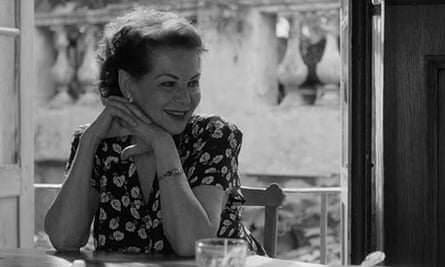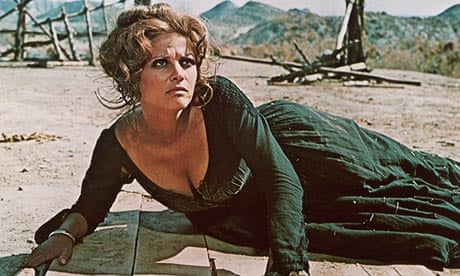There's nothing Claudia Cardinale hates more than staying still, but for the past two months she's had to do exactly that. She broke her foot on holiday in Tunisia and has since been holed up in her Paris flat. "It was stupid," she says, in her distinctive Mediterranean rasp. "I was playing volleyball. There was water on the edge of swimming pool, and I slipped. I like to be active, so when I have to sit for two months without going out, it's terrible. I had many places to go and I had to refuse: Venice, Kiev, Osaka. Now it's OK. Yesterday I went out for the first time, but the weather is ugly."
Cardinale is a survivor from the era when movie giants walked the earth – most of them alongside her. She was closing down those degrees of separation when Kevin Bacon was still in short trousers. But where former co-stars like John Wayne, Burt Lancaster, Marcello Mastroianni and Brigitte Bardot are all retired or deceased, Cardinale is still walking, volleyball accidents aside. Now 74, she has made over 135 films in the past 60 years, and still does two or three a year. Added to which, her part in classics like 8½, The Leopard, Once Upon a Time in The West and Fitzcarraldo keep her busy on the festival and "lifetime achievement award" carousel.
"I don't want to stop!" she laughs. "This is fantastic, to continue to work. It's important." Why does she keep going? She laughs again. "I don't know."
Thanks to her longevity, Cardinale is now a database of golden-age movie gossip. John Wayne and Rita Hayworth? "He was so big, and she was so beautiful. Gilda for me was the best. She was my mother, and he was my father [in 1964's Circus World]. Can you imagine?" The Pink Panther? "Peter Sellers didn't speak to anybody. Always in the corner, just the opposite of what you see in the film. Blake [Edwards, director] was fantastic. Crazy. And I love crazy people." I mention Tony Curtis, her co-star in California comedy Don't Make Waves. "Ah! Incredible. When was that?" We are speaking by phone, and I can hear something being shuffled. "I have lots of papers with everything written," she says. "Otherwise, I don't remember dates." Shuffle shuffle. "Ah, si, oui. It was just before Once Upon a Time in the West. Oh yes, 1968. We shoot, oh my God, long time. I don't remember!"
Reading this on mobile? Click here to view video
Fresher in her memory is The Artist and the Model. Directed by Spain's Fernando Trueba, it's a contemplative, languorous tale centred on a semi-retired sculptor (played by French screen veteran Jean Rochefort) living in the Pyrenees during the second world war. Cardinale plays his supportive wife, who takes in a young Spanish vagrant one day and suggests she model for her husband. Inevitably, the Mediterranean sunlight on lissom flesh restores Rochefort's creative mojo. Cardinale is only in the movie for a few scenes, but she still exudes the same liveliness and warmth she did in her youth.
Predictably, Cardinale and Rochefort had worked together before – in a 1962 swashbuckler called Cartouche, also starring Jean-Paul Belmondo. The New York Times lecherously approved of her: "a quick, flashing smile, a pleasingly husky voice and a sense of humor add to the physical attributes not hidden by her Gypsy costumes".
It's no disservice to give those physical attributes some of the credit for Cardinale's success. A generation of postwar cinephiles rhapsodised over her earthy voluptuousness, her hourglass figure, her "bedroom eyes", her cascading brunette tresses. She was the embodiment of postwar European glamour and was packaged as such, on screen and off. It's almost like she had sexiness thrust upon her.
Cardinale never set out to be an actor. Her career began after she won a beauty contest she hadn't even entered: at the age of 18, she was plucked out of a crowd and crowned Most Beautiful Italian Girl in Tunisia (where she grew up). The prize was a trip to the Venice film festival, where she received many offers from producers. She turned them all down initially. "It's like a man," she says. "When he's going after you, if you say yes immediately, after a little time he goes away. If you say no, he desires you for a long time."
There was another reason, though. Cardinale was pregnant and would shortly give birth to a son. She never revealed the identity of the father, though later told a French magazine she was raped. Eventually, she accepted the approaches of the producer Franco Cristaldi, who put her under contract for 18 years – and married her. Under his management, Cardinale was moulded into Italy's answer to Brigitte Bardot. Her life was strictly controlled: not just movie roles but also her hairstyle, weight, social life. The world was told that her son was her younger brother, and he was raised by Cardinale's family.
It is now 50 years since Cardinale's big breakthrough via two Italian classics: Federico Fellini's 8½ and Luchino Visconti's The Leopard. In both, she was cast as an idealised, almost unattainable object of desire. In the former, she plays a sought-after movie star and ethereal muse, who seems to exist on a plane above the chaos swamping Marcello Mastroianni, playing a put-upon film-maker. In the latter, she's an 19th-century beauty, lusted after by both Burt Lancaster's fading aristocrat and his nephew, Alain Delon. Cardinale made them at the same time, flitting from Fellini's modernist, black-and-white vision of Rome to Visconti's sumptuous recreation of 19th-century Sicily. "Federico wanted me blonde," she says. "Luchino wanted me brunette. With Fellini you have no script – it is all improvisation. When he was shooting, all the actors came to see him because he was magic. The set was like a circus, people shouting down phones. He couldn't shoot without noise. With Visconti, the opposite, like doing theatre. We couldn't say a word. Very serious."
By the end of 1963, 8½ had won the best foreign film Oscar, The Leopard took the Palme d'Or at Cannes, and The Pink Panther, in which she played a seductively drunken princess, was becoming a global phenomenon. It wasn't just the public who wanted a piece of Cardinale, though. She has been romantically linked with friends and co-stars, including Steve McQueen, Belmondo, Mastroianni and Delon, but she is famously tight-lipped about her personal life. The only suitor she'll admit to is the one that got away: Marlon Brando.
She blames herself, she says, for telling everyone when she first went to Hollywood that Brando was her idol. One night, he came knocking. "He said something about how we were both Aries. He was very charming and funny, but I was just laughing. I turned him away. But when I closed the door, I said to myself, 'You are so stupid!'"

Unlike other sex symbols of the era, Cardinale found a way through. For her friend and counterpart Brigitte Bardot, the burden of celebrity proved too great and she quit the business in 1973 – shortly after the two teamed up for comedy western Les Petroleuses (the billing of BB vs CC didn't live up to expectations). Cardinale broke free of her contract and divorced Cristaldi in 1975. She did a great many terrible movies in the 1970s and 80s, and some even worse disco records, but getting older and stepping out of that sexualised glare seems almost to have been a relief. She never really did it for the glamour, she says. "When I was young, my dream was to explore the world. And I did it." Acting was just the passport and, despite the demands of the patriarchal movie system, she managed to hold on to her soul. "I was never naked and I never did anything to change my face. I don't like that at all. I like to be what I am, because you cannot stop time."
She never had bodyguards or drivers, she liked to do her own stunts, and many directors have praised her general lack of pride. In his diary of the making of Fitzcarraldo, Werner Herzog writes of her as an antidote to the all-consuming megalomania of his star, Klaus Kinski: "Claudia Cardinale is great help because she is such a good sport, a real trouper, and has a special radiance before the camera. In her presence, [Kinski] usually acts like a gentleman." Cardinale was never scared of Kinski, she says. "He was scared of me!"
She's still at it, still exploring the world. "After The Artist and the Model, I did a film with Manuel d'Oliveira. He is 103, can you imagine? And before, I did a film in Italy, and also one in New York with a very young director. And after that I did a movie in Austria with another young director, and the last one was Effie, a British film, with Emma Thompson."
Effie, now in post-production, tells the story of Victorian writer John Ruskin and his young bride. "It was in Venice – it was so hot and we had these big costumes. We couldn't eat, we couldn't go to the toilet. Nothing!"
She laughs. After two months of immobility, she is clearly itching to get back to work. "I have three scripts I have to read this week," she says. "I would like to get moving again."
The Artist and the Model is released tomorrow.

Comments (…)
Sign in or create your Guardian account to join the discussion